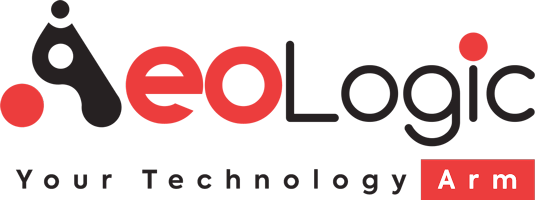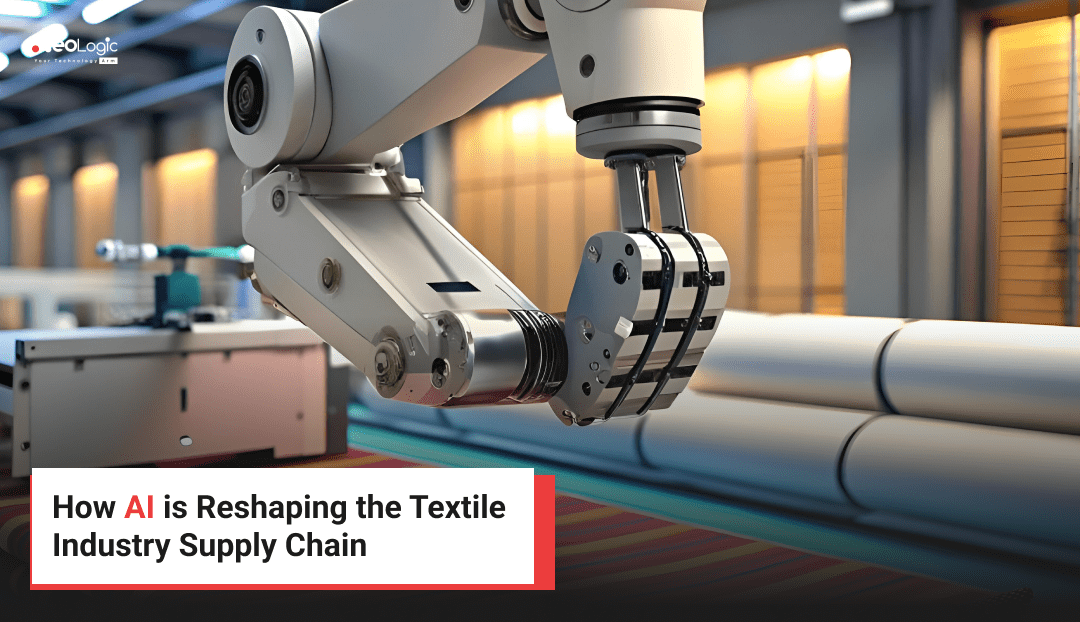People in the textile space are looking for clear solutions to longstanding problems in the industry including delays, waste, and quality assurance. They are hoping new tech solutions can help. AI in Textile Supply Chain, is fast becoming the solution many businesses need to remain competitive in an efficient way.
Not only does this technology offer automation, it also brings intelligence and speed to decision-making.
Finding the right AI solutions can be hard – this is why companies like Aeologic Technologies have to rely on experts to navigate the AI supply chain in textiles. Aeologic’s know-how in AI in Textile Supply Chain helps companies eliminate common pitfalls and deliver genuine results quickly.
Make sure to pass this post on to anyone in the industry who wants to explore how significant AI in the Textile Supply Chain could be.
What is AI in Textile Supply Chain?
AI in Textile Supply Chain refers to the use of intelligent machines and software to streamline the flow of materials and products, from fiber to finished garment. Compared to pre-AI methods where stakeholders relied on manual checks and intuition, AI speeds up the decision-making process using data, previous experiences, patterns and algorithms.
To analyze past sales data, future sales forecasts, and even market-level trends like the weather, AI can more accurately predict how much fabric a company will need over the next few months. AI also helps eliminate excessive inventory and avoid stock that causes interruptions while manufacturing or shipping.
The use of AI and the IoT is increasing in the textile industry, as per estimation the AI software market may have crossed over US$60 billion by 2024.
I believe we will see this trend grow rapidly, the adoption of these intelligent technologies is happening quickly to help companies operate efficiently and reduce wasteful practices.
AI in Textile Supply Chain is not simply automation, it is construction smart, lean, and more responsive supply chains that quickly adapt to market forces.
Looking for? Top AI Consulting & Custom Solution Providers in 2025
How AI is Used in Textile and Garment Industry
AI leveraged at multiple points in the textile and garment sector is helping to improve productivity and product quality. In fabric production, AI-assisted machines are able to monitor the tension of threads, guide the speed of weaving, and produce even materials to further reduce defects and potentially save expensive rework.
Quality control has also benefited. AI technology uses cameras and sensors to identify defects that may not be detected by the human eye. This increases the assurance of delivering quality fabric into production and minimizes waste.
Another strong improvement area is demand forecasting. AI analyses the sales data and trends to expose what products will sell at best. This supports the company with production planning and even prevents overproduction and underproduction.
In garment production, AI is evolving into more automatic cutting patterns and sewing. Pattern recognition technology helps to quicken the design development process and decrease time to market while giving more customization choices to customers.
These advances support that Artificial Intelligence is no longer just a concept in the textile industry and it has been taken into common practice. Enhancements of efficiency and precision in every phase of the manufacturing process form a foundation for a more resilient and flexible supply chain.
What Are the Benefits of AI in Textile Supply Chain?
AI is transforming textile supply chains by making operations faster, smarter, and more reliable. From raw materials to finished products, every step benefits from improved accuracy and data-driven decisions. These changes help companies save costs, reduce waste, and meet customer demands better than ever before.
Improved Inventory Management
Inventory has always been difficult for textile organisations. If a company over – sinks inventory, it tie – up capital, and increases storage costs. If a company runs out of material, it can halt future production, or delay an entire shipment.
AI solutions for inventory make predictions su – sequence by analyzing historical sales orders, current markets, and even external factors like seasonal demand or shifts in the economy. It predicts—and says how much of each material—in advance the company will need and if it has make the right choices based on accurate sales data. If everything works as accurate as possible, the company holds exactly what it needs. The benefit is reduced waste – and better cash flow.
Explore more: Top AI Development Companies That Help Businesses Scale
Shorter Lead Times and Smoother Production
The complex supply processes in textile supply chains result in long lead times, highlighting the challenge of managing multiple vendors in the textile supply chain. AI serves to enhance the scheduling function, effectively optimizing all facets of production and order fulfillment, including shipping and materials handover by leveraging real-time data.
AI gives companies the leverage to react more quickly to outlined scenarios in the marketplace that may cause an unplanned demand or a supply disruption. If a shipment is delayed, AI’s machine learning algorithms will effectively evaluate the production schedule with the least impact of a late shipment and immediately adjust the production schedule.
If the customer is sensitive to the time, this overall efficiency allows the textile supply chain company to compress the time from order to fulfillment, improving customer satisfaction, leading to loyalty.
Also Read: How to Find the Best Digital Transformation Partner?
Predictive Maintenance Reduces Downtime
Machine breakdowns cause costly delays in textile manufacturing. AI-powered sensors continuously monitor equipment health and detect early signs of wear or failure. This predictive maintenance alerts managers before machines stop working, allowing repairs or part replacements during planned downtime.
Textile companies using AI report up to a 30% reduction in unexpected downtime.
This reliability means smoother production flow and lower operational costs.
Enhances Customer Experience Through Personalization
Customers today expect more than everyday products. They expect personalization and a faster speed to market. The retail AI solution can collect, analyze, and synthesize customer preference, buying behavior, and market trends, enabling companies and customers the ability to mass customize.
This means, for example, a company can mass sell custom fabrics, styles, or design (think shoes) without delay to time to market. All things considered, a fast lead time and customized product will contribute to customer loyalty and improve the opportunity for sales.
Also Read: How IoT and AI are Transforming Logistics?
What Challenges Does AI Face in the Textile Industry?
Despite the advantages, AI implementation in the textile industry has a few substantial barriers of concern. The first major challenge is the data quality. AI is dependent on clean and accurate data to make appropriate recommendations. Many textile organizations still struggle with partial or unintegrated data, which severely hinders AI effectiveness.
Another challenge is the integration of AI with other systems. Many older machines and software do not always integrate easily with new AI products. The lag time adds cost to the integration process.
The third operational challenge is finding experienced personnel to run AI projects. This is where AI consultancy services in India play an important part; they can offer SME (small medium enterprises) clients knowledge and experience.
Top AI consulting companies constantly work with textile businesses, and assist clients with unique interventions to mitigate these challenges. Aeologic, for instance, works within this field and solves these exact issues through their consulting business model and successful project delivery.
For businesses to take full advantage of the AI -enabled value within the Textile Supply Chain, these challenges should be addressed and terminated early.
How Can Companies Start Implementing AI in Their Supply Chains?
Starting AI in the textile supply chain requires careful planning. First, companies must assess their current processes and data readiness. Clear goals should be set to focus on the most impactful areas, like inventory or quality control.
Choosing the right AI consulting partner is critical. Experienced consultants guide businesses through technology selection and integration, reducing costly mistakes. Companies should look for providers who understand the textile industry’s needs deeply.
Small-scale pilot projects allow companies to investigate or test AI tools with limited exposure. This method allows project teams to learn from the experience and move forward with integrating AI into the organization. Further pilot successes will affirm confidence in the AI solution and confirm the value of the new capability and innovation.
Lastly, bolster employees’ adaptation to new technology by providing the relevant training and ongoing user support systems. Furthermore, change management will be necessary to communicate new AI benefits, ensure that all employees are familiar with their processes through AI, and facilitate knowledge transfer.
By using these steps, companies can take a clear pathway to introduce AI smoothly and transform their supply chain(s).
Also Read: Role of Artificial Intelligence in Logistics Business
Why Is AI Investment Growing in the Textile Industry?
Artificial intelligence (AI) is rapidly growing in the area of textiles, fueled by clear business advantages and growing consumer demand.
The global AI in the textile market is projected to have a compound annual growth rate (CAGR) exceeding 40% from 2023 to 2028. Specifically, MarketsandMarkets expects the AI in fashion market to grow from USD 228 million in 2019 to USD 1,260 million by 2024, with a CAGR of 40.8%. Other reports, like Data Bridge Market Research, indicate a 38.85% CAGR by 2028, with a market size of USD 3.14 billion.
This growth presents an opportunity for companies to seize, as the industry prioritizes efficiency, cost savings, and quick delivery.
According to Avery, robotics powered by AI is now able to undertake complex tasks and is capable of cutting fabric and managing sewing with precision. AI has allowed for the design of real-time tracking systems to help textile managers understand every step of the supply chain process. This can improve visibility and coordination to avoid delays.
With evolving changes in consumer demand for sustainable, customizable, and unique products, those companies that leverage early adoption will be able to reduce waste and react quickly to sustainable and custom trends. AI will allow company managers to respond quickly, as it is a growing consumer demand.
This strong trend shows why investing in AI in textile supply chain is becoming a priority for industry leaders.
How Will AI Change the Future of Textile Supply Chains?
AI will transform textile supply chains by making them smarter and more sustainable. In the future, AI-powered systems will predict disruptions before they happen. This will allow companies to avoid costly delays and keep production on track.
Sustainability will improve as AI optimizes resource use and reduces waste throughout the process. AI will also enable greater customization, allowing brands to deliver personalized products faster and at scale.
The workforce will evolve too. AI will handle repetitive tasks, freeing workers to focus on creative and strategic roles. This shift will require new skills and ongoing training.
The companies that adopt AI early will lead the market by being more agile, cost-efficient, and customer-focused. AI in Textile Supply Chain is not just a tool but a key to future success.
Also Read: The Importance of AI Solutions in Supply Chain Management
Final Take
AI in Textile Supply Chain is reshaping how the industry operates. It boosts efficiency by improving inventory management and cutting production downtime. It also enhances customer satisfaction through personalized products and faster delivery. Yet, challenges like data quality and skilled workforce needs must be addressed. Partnering with experts such as Aeologic helps companies overcome these hurdles and implement AI smoothly.
Exploring AI solutions now positions textile businesses for future success. The technology promises smarter, more sustainable supply chains that adapt quickly to market demands.
FAQs
What role does AI play in improving the textile supply chain?
AI simplifies the supply chain of the fabric industry, due to its capability to automate inventory level predictions, forecast demand, and optimize manufacture schedules. The key to AI’s efficiency is its ability to analyze vast volumes of data and make projections that decrease waste and, therefore, reduce costs.
Once it has processed the large amounts of data available to it, AI will improve its ability to assist humans in making decisions by allowing real-time visibility into the supply chain and supporting textile manufacturer’s capacity to adapt to movements in the consumer space and current market trends, thus increasing efficiency and adaptability in the industry. Ultimately, lenders could expect manufacturers to be able to decrease lead times due to improve flexibility of their supply availability.
Constantly adapting to aggregate insight from consumer market inputs would potentially also improve customer satisfaction and decrease turnover in purchases. Greater levels of automation and predictive analytics can reduce routine tasks for the human resources necessary to produce fabric, particularly when it focuses on higher levels of strategic work for the determination of supply. If the human resources can devote more of their available time to strategic efforts, improved strategic cost controls and potentially sustainability efforts will thrive across the textile space.
How can AI-driven demand forecasting benefit textile manufacturers?
AI demand forecasting relies on historical sales data, market trends, and exogenous influences to accurately predict demand. This lowers the likelihood of overproducing or running out of stock, netting savings in inventory and waste.
With AI demand forecasting, textiles manufacturers can better plan production schedules and purchases of raw materials, so they use resources more efficiently. Improved demand forecasting also facilitates timely service and fulfillment of customer demand.
Manufacturers can remain competitive and agile by anticipating market changes. All in all, AI-powered demand forecasting minimizes costs, optimizes redundancies in terms of inventory and waste, and promotes a more sustainable manufacturing business model.
Can AI improve quality control in textile manufacturing?
AI enhances quality control by leveraging advanced computer vision and machine learning to detect defects in fabrics and finish products.
AI systems speed up the textile scanning process and improve accuracy when compared to human inspections and can find defects like color inconsistencies, tears in the fabric, or irregularities in the weave earlier in production runs.
AI-based quality control helps reduce human error, decrease scrap rates, and improve product consistency.
As a result, customers are more satisfied, while limiting the impact associated with return or rework costs. By adopting AI, textile producers can enforce strict quality standards while improving overall productivity.
How is AI transforming supplier relationship management in textiles?
AI improves supplier relationship management through data-driven insights on supplier performance, reliability of delivery and quality.
It supports real-time monitoring and an early warning of potential problems, enabling proactive working together to rectify the issue. AI-based tools reinforce communications, comply with contracts, and follow up on shared negotiation strategies.
AI uses historical and market-based data sets to determine the best suppliers, optimize sourcing decisions, encourage trust and transparency between manufacturers and suppliers, limit risk and improve supply chain disruption.
How does AI help reduce costs in the textile industry supply chain?
AI can help reduce costs by optimizing inventory levels, eliminating waste, and increasing the accuracy of demand forecasts to reduce the likelihood of overproduction.
Automation decreases labor costs by minimizing the human effort required for repetitive tasks such as purchase order processing, and/or documentation. AI-enabled route optimization cuts transportation costs by flagging the most efficient delivery routes; while predictive maintenance will reduce costly downtime and repairs.
AI will allow textile companies to save costs at every stage in the supply chain through effective resource management and error reduction. Implementing cost savings provides the opportunity for a bigger margin, or a greater price competitiveness in the market.

I’m Deepika Pandey, an SEO strategist and content writer with 6+ years of experience. I create SEO-friendly content that drives traffic and engages readers. I combine data insights with creativity to help businesses grow their online presence effectively.







